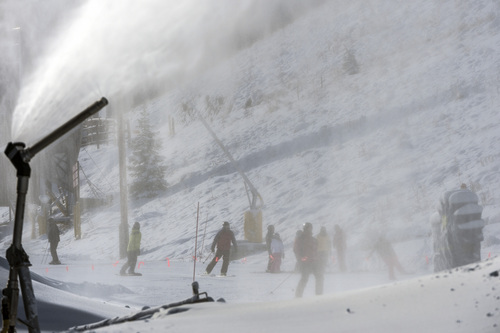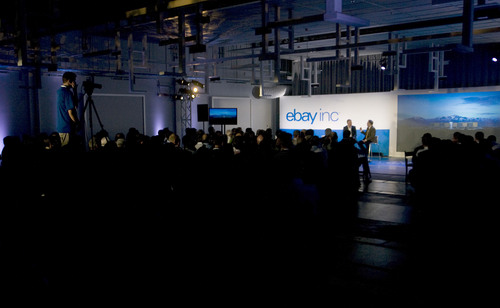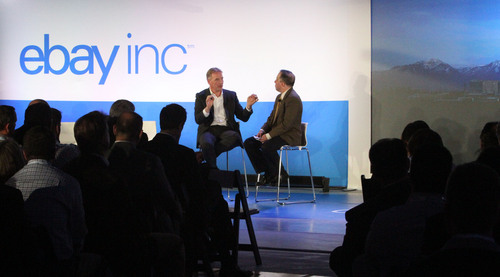This is an archived article that was published on sltrib.com in 2014, and information in the article may be outdated. It is provided only for personal research purposes and may not be reprinted.
Making snow requires a lot of electricity. Utah's Park City Mountain Resort, along with other Summit County businesses, wants to obtain power from wind, sun and other renewable sources that don't emit greenhouse gases.
That kind of choice, while available in six other states, is not available in Utah. But it could be, if state lawmakers figure out a way for consumers and businesses to buy green power without shifting the costs of transmission to other ratepayers.
"It's a tough deal to work through, but it has to be worked through," said Brent Giles, sustainability director for the resort's parent Powdr Corp.
The market for renewable-power sources is restrained by a lack of competition, say reform proponents such as Summit County Council member Roger Armstrong. Many Utahns who oppose reliance on coal would like the power to "vote with their pocketbooks," but the current system won't let them.
Rocky Mountain Power, a regulated monopoly adept at keeping rates low, decides how to generate the electricity filling most of Utah's grid. For now it's coming mostly from coal, although natural gas is taking a growing share.
This legislative session, Rep. Kraig Powell, R-Heber City, introduced HB110, a bill that would enable cities and counties to make bulk electricity purchases from renewable sources on behalf of residents who want it — even if they have to pay extra.
While "community choice aggregation" would stimulate demand for renewable power, it could also drive up costs for everyone, some observers warn.
—
Parsing power bills • Such an arrangement appears simple, but it's anything but, according to Utah's largest utility.
Much of what Rocky Mountain Power (RMP) bills ratepayers supports a massive pool of fixed costs associated with the wires, poles, substations and transformers that route the energy from generating sources to ski lifts, homes, industry and businesses.
"Because of the way electricity behaves, this is the only service that has to be manufactured and delivered in the same instant that the customer wants it," RMP spokesman Dave Eskelsen said. "That's what makes the pricing so complicated."
Accommodating choice is a minefield for states such as Utah, where state policy limits access to electrical-distribution infrastructure to sole purveyors.
If the legislation is not carefully drafted, power users receiving electricity from alternative sources could avoid covering their share of the utility's fixed costs, which could then get spread to everyone else, according to Michele Beck, who directs the state Office of Consumer Services.
"I want to make sure we do it in a way that is administratively efficient and doesn't shift costs," Beck said.
Generation costs, those associated with building and operating power stations, accounts for less than a third of a typical monthly bill for RMP residential customers. Transmission accounts for 14 percent; distribution 32 percent; and purchased power 23 percent.
—
'A new wheel' • Choice advocate Shawn Marshall, who helped create a green power authority in California's Marin County, acknowledges setting up community aggregation would be hard in Utah. But Marshall contends RMP can do it without costly investments in new meters.
It's largely a matter of separating the cost of generating the power from those associated with transmitting and distributing it, he said, then billing customers on a city's aggregated plan to ensure their rates do cover RMP's fixed costs.
The Utah Public Service Commission would have to develop tariffs and rules, Marshall wrote in an email, adding that "there are lessons that can be learned and practices borrowed from California that can save Rocky Mountain and the utilities commission both time and money."
Beck says that model works in states that have restructured their power markets so that ratepayers are billed separately for the energy they use and the cost of delivering it. But Utah's system poses hurdles.
"It's not that we have to reinvent the wheel. We have to invent a new wheel," said Beck, who serves as a consumer advocate before the PSC.
"Maybe we could protect existing customers, but it would take considerable time to work this through, and I wonder if there aren't better models," Beck said.
She wants to see power users have choice, but said recent experience has shown that such "open access" states have higher rates. For example, Utahns pay on average 10.1 cents per kilowatt hour versus the 16.8 cents in California, according to RMP.
—
'Demanding more options' • Because of these concerns, lawmakers holstered HB110 for interim study. The bill hopes to build on a law enacted two years ago that allows large businesses to buy green power delivered through RMP's network.
Powell, the sponsor, wants to expand that provision to enable cities and counties to pool such purchases for their residents.
The original law was tailor-made for eBay, which wanted to power its new South Jordan data center from a carbon-free source.
That was easy to implement because there is direct link between the customer and the supplier, David Taylor, RMP's director of regulatory affairs, told lawmakers last week.
"SB12 required the customers to bear all the costs. A key provision was to segregate the power and you have to do it hour by hour, not aggregate it at the end of the month," he said. "It's challenging when a customer is buying service from multiple suppliers. It doesn't mean it cannot be done, but it's very challenging."
Other Utah companies have yet to use the law to buy green power. Powdr Corp. would like to, Giles said, but the two-megawatt purchase threshold has turned out to be an obstacle.
Giles would like the state to mandate the utilities to get a certain share of their power from renewable sources, but such an idea is politically unpalatable in market-oriented states such as Utah.
Advocates for reform say the costs of wind, solar and geothermal power will become more favorable as their use grows.
"While it is more expensive now, prices are dropping, while prices for traditional sources are rising," said Vicki Bennett, Salt Lake City's sustainability director. "Our citizens are demanding more options. Businesses looking to relocate to our region are asking for options. We want to be part of this."
Powering the utility
As of 2012, 59 percent of the power Rocky Mountain Power delivered came from coal. But that share is projected to drop to 49 percent by 2022, as the utility retires and converts parts of its coal fleet.
About 15 percent of the utility's power comes from renewable sources, much of it from wind farms in Wyoming. Other power is purchased by the company.













